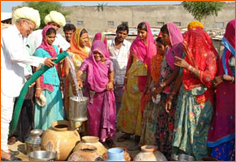 |
This is a kind of check dam commonly constructed across small streams to conserve stream flows with practically no submergence beyond stream course. |
|
|
 |
A small bund across the stream is made by putting locally available boulders in a mesh of steel wires and anchored to the stream banks. |
|
|
 |
The height of such structures is around 0.5 m and is normally used in the streams with width of less than 10 m. |
|
|
 |
The excess water over flows this structure storing some water to serve as source of recharge. The silt content of stream water in due course is deposited in the interstices of the boulders. With the growth of vegetation, the bund becomes quite impermeable and helps in retaining surface water run off for sufficient time after rains to recharge the ground water body. |
|
|
| Ground water recharge in urban areas |
|
|
 In urban areas, rain water available from roof tops of buildings, paved and unpaved areas goes waste. This water can be recharged to aquifer and can be utilized gainfully at the time of need. The rain water harvesting system needs to be designed in a way that it does not occupy large space for collection and recharge system. A few techniques of roof top rain water harvesting in urban areas are described below. In urban areas, rain water available from roof tops of buildings, paved and unpaved areas goes waste. This water can be recharged to aquifer and can be utilized gainfully at the time of need. The rain water harvesting system needs to be designed in a way that it does not occupy large space for collection and recharge system. A few techniques of roof top rain water harvesting in urban areas are described below. |
|
|
| Percolaiton Tank |
|
|
 |
Percolation tank is an actually created surface water body, submerging in its reservoir a highly permeable land, so that surface runoff is made to percolate and recharge the ground water storage. |
|
|
 |
Percolation tank should be constructed preferably on second to third order streams, located on highly weathered rocks, which have lateral continuity down stream. |
|
|
 |
The recharge area down stream should have sufficient number of wells and cultivable land to benefit from the augmented ground designed for storage capacity of 0.1m to 0.5 MCM. It is necessary to design the tank to provide a ponded water column generally between 3and 4.5m. |
|
|
 |
The percolation tanks are mostly earthen dams with masonry structure only for spillway. The purpose of the percolation tanks is to recharge the ground water storage and hence steepage below the seat of the bed is permissible. For dams upto 4.5 m in height, cut off trenches are not necessary and keying and benching between the dam seat and the natural ground is sufficient. |
